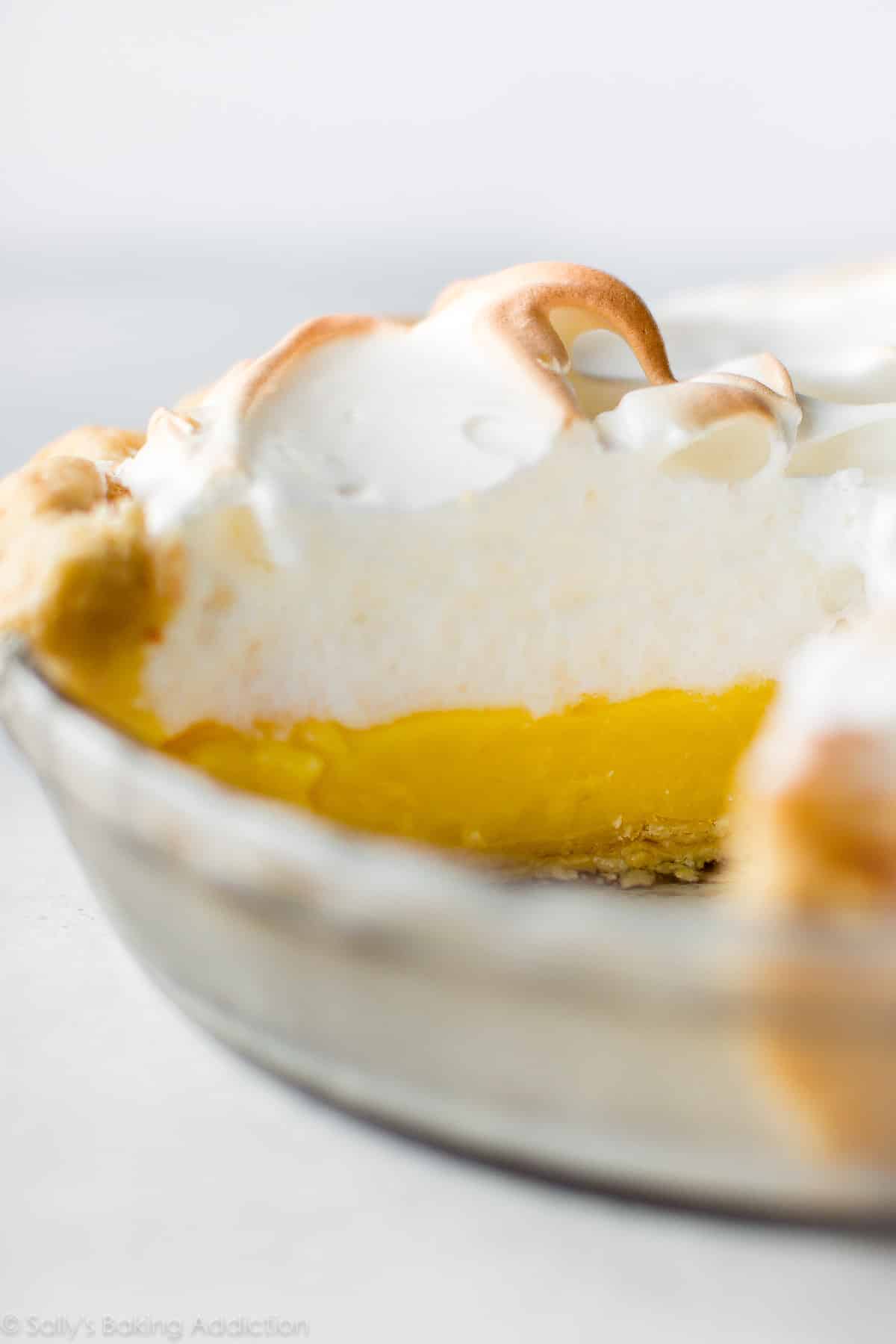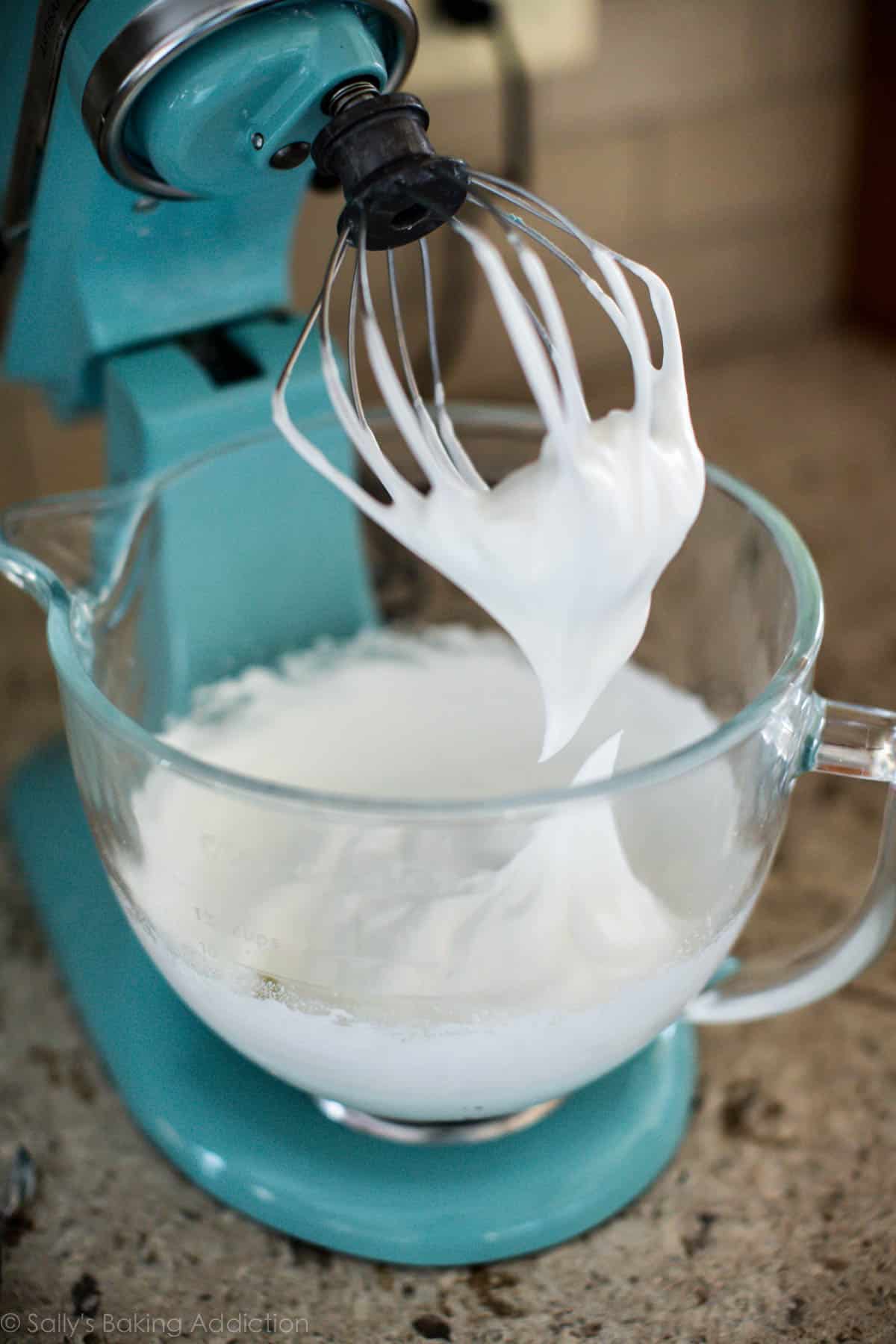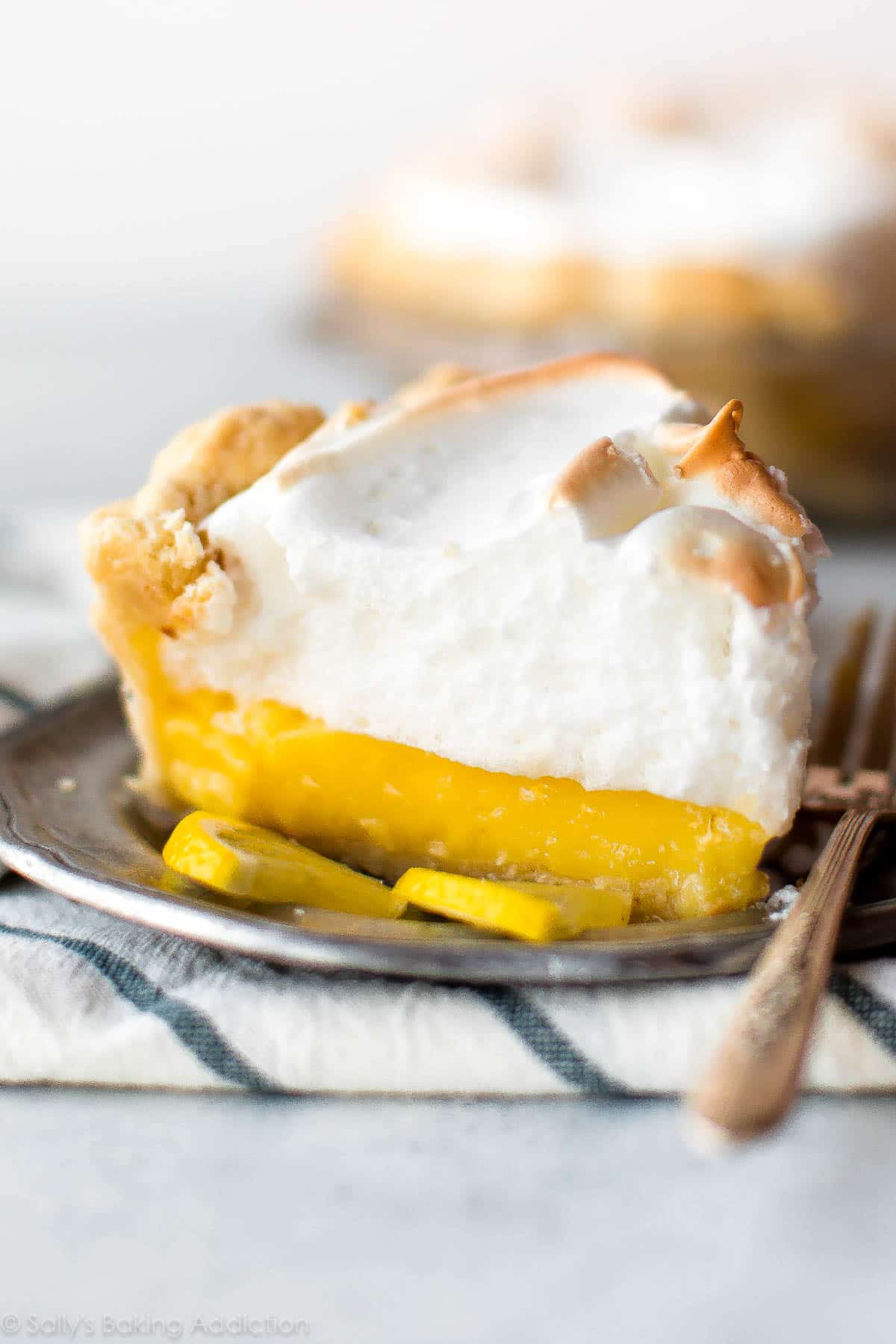This is the perfect lemon meringue pie! With a delicious homemade pie crust, tart and smooth lemon filling, and a fluffy toasted meringue topping, it’s impossible to resist.

Let’s welcome a fresh new season with a fresh new pie—the pie I’ve been taunting you with for weeks!! The beautiful, the timeless, the Classic Lemon Meringue Pie.

My lemon meringue pie recipe has a billowy and toasty meringue topping, a balanced sweet/tart lemon filling, and an extra thick and flaky pie crust. I worked on this recipe for a long time, making at least a dozen meringue pies in the past few months. Both my kitchen and head were exploding lemons. Whenever we had friends or family stop by, I’d force lemon meringue pie on them. “PLEASE TELL ME YOUR THOUGHTS” I begged while barely blinking.

How to Make Lemon Meringue Pie
Over the years and especially the past few months, I learned that lemon meringue pie can be a daunting process but it doesn’t have to be. Let me make this recipe easy for you by giving you a tested (and praised!!!) recipe, lots of helpful recipe notes, and a video so you can watch it come to life. Perhaps you’re looking for Easter dessert recipes? Celebrating a birthday? Or just want to enjoy a beautiful lemon-y pie? No matter your reason, I’ve got you 🙂
- Blind bake pie crust
- Prepare lemon meringue pie filling
- Whip meringue topping
- Spread meringue on top of filling
- Bake pie until toasty brown on top
Now that you have a general idea of the process, let’s learn why this lemon meringue pie recipe works and what mistakes to avoid.

Here’s Why This Recipe Works
There are 3 main roadblocks when making lemon meringue pie: a soggy pie crust, a watery lemon filling, and/or a weeping meringue. Let’s work through each.
- Let’s avoid a soggy pie crust: Start by reviewing how we blind bake pie crust. You want to partially blind bake the crust because it will continue to bake when you bake the assembled lemon meringue pie. Watch me blind bake the crust I use for this lemon meringue pie in my separate post on how to blind bake pie crust. Lots of tips and tricks there. And to get those pretty decorative edges, see my how to crimp and flute pie crust tutorial.
- Let’s avoid a watery lemon filling: This is where I always had the most trouble. Lemon meringue pie filling is basically a thinner version of lemon curd. You’ll temper egg yolks. And before you run away screaming, watch me do this in the video below. Promise it’s not scary. While lemon meringue pie filling should be blissfully creamy, we also want it to be stable enough to slice somewhat neatly. (Think: a slightly firmer version of pudding, but not as firm as jello.) There was a lot of back and forth with the water vs lemon juice vs cornstarch vs sugar amounts. Follow my lemon meringue pie filling below. It’s not too tart, not too sweet, and has the silkiest, yet not-too-watery texture.
- Let’s avoid a weeping meringue: There are many different types of meringue topping, but let’s use a French meringue. Beat egg whites into soft peaks, add sugar, then beat into stiff peaks. Unless you want to waste a bunch of egg whites in failed meringue attempts, read these tips: Make sure you begin with just egg whites. Not even a drip of egg yolks. Make sure the bowl you’re using is completely wiped clean. No oil or water residue. Make sure you add cream of tartar. This will stabilize your meringue. Make sure you add the sugar *after* soft peaks are formed. If added before that, the egg whites could stretch too much which prevents a stiff peak altogether. (These tips apply for my chocolate swirled meringue cookies, too.) Make sure you spread the meringue topping so it touches the pie crust. This seals the lemon filling underneath and allows the crust to grip onto the meringue so the two do not separate. And, finally, don’t make lemon meringue pie on a humid day.

How to Make Lemon Meringue Pie Topping
The meringue toasts in the oven. A lot of recipes call for putting the whole pie under the broiler, but I prefer to bake it so that the egg whites have a chance to cook through. Also, see the end of step 6 in the recipe below. Make sure you spread the meringue topping on while the filling is still warm. The warm filling helps seal the two layers together, preventing separation.
- Did you know? (1) Room temperature egg whites whip faster than cold egg whites. And (2) room temperature egg whites whip into a greater volume than cold egg whites. So make sure your egg whites are at room temperature before starting the meringue.
- Time saving tip: You need 5 egg yolks for the lemon filling and 5 egg whites for the meringue topping. Separate the 5 eggs while they are cold. (Cold eggs separate easier! Remember NO egg yolks in the meringue, not even a smidge.) Leave the egg whites out on the counter. Blind bake the pie crust and prepare the lemon filling. By the time you’re ready to start the meringue, the egg whites will be room temperature.
Meringue can be tricky, but you’re a baker and you can absolutely handle this.

Craving something smaller? Here is my lemon bars recipe.
Print
Classic Lemon Meringue Pie
- Prep Time: 6 hours
- Cook Time: 1 hour, 10 minutes
- Total Time: 7 hours, 10 minutes
- Yield: one 9-inch pie
- Category: Pie
- Method: Baking
- Cuisine: American
Description
This is the perfect lemon meringue pie! With a delicious homemade pie crust, tart and smooth lemon filling, and a fluffy toasted meringue topping, it’s impossible to resist.
Ingredients
- Homemade Pie Crust*
- 5 large egg yolks (use the whites in the meringue below)
- 1 and 1/3 cups (320ml) water
- 1 cup (200g) granulated sugar
- 1/3 cup (38g) cornstarch
- 1/4 teaspoon salt
- 1/2 cup (120ml) fresh lemon juice
- 1 Tablespoon lemon zest
- 2 Tablespoons (28g) unsalted butter, softened to room temperature
Meringue
- 5 large egg whites, at room temperature
- 1/2 teaspoon cream of tartar
- 1/2 cup (100g) granulated sugar
- 1/8 teaspoon salt
Instructions
- Pie crust: I like to make sure my pie dough is prepared before I begin making lemon meringue pie. I always make pie dough the night before because it needs to chill in the refrigerator for at least 2 hours before rolling out and blind baking (next step).
- Preheat oven to 375°F (190°C) and adjust your oven rack to the lowest position. Partially blind bake pie crust in a 9-inch pie dish. (Follow blind baking instructions through step 9. Be sure to crimp or flute the pie crust edges, too.) Tip: You can get started on the lemon meringue pie filling steps while your crust is blind baking. But making the filling is time sensitive because you will temper the egg yolks, so if multi-tasking isn’t your thing, just wait until your crust is done blind baking before beginning the filling.
- Reduce oven temperature to 350°F (177°C).
- Watch the video below to see how I work through each of the following steps.
- Make the filling: Whisk the egg yolks together in a medium bowl or liquid measuring cup. Set aside. Whisk the water, granulated sugar, cornstarch, salt, lemon juice, and lemon zest together in a medium saucepan over medium heat. The mixture will be thin and cloudy, then eventually begin thickening and bubbling after about 6 minutes. Once thickened, give it a whisk and reduce heat to low.
- Temper the egg yolks: Very slowly stream a few large spoonfuls of warm lemon mixture into the beaten egg yolks. Then, also in a very slow stream, whisk the egg yolk mixture into the saucepan. Turn heat back up to medium. Cook until the mixture is thick and big bubbles begin bursting at the surface. Remove the pan from heat and whisk in the butter. Spread filling into the warm partially baked crust. Set aside as you prepare the meringue. (Don’t let the filling cool down too much as you want a warm filling when you top with the meringue in step 7. The warm filling helps seal the two layers together, preventing separation.)
- Make the meringue: With a handheld mixer or a stand mixer fitted with a whisk attachment, beat the egg whites and cream of tartar together on medium speed for 1 minute, then increase to high speed until soft peaks form, about 4 more minutes. Add the sugar and salt, then continue beating on high speed until glossy stiff peaks form, about 2 more minutes. Spread meringue on top of filling. (I like to make decorative peaks with the back of a large spoon.) Make sure you spread the meringue all the way to the edges so that it touches the crust. This helps prevent the meringue from weeping.
- Bake pie on the lowest oven rack for 20-25 minutes. (If the meringue is browning too quickly, tent a piece of foil over it as best you can without the foil touching the meringue.) When pie is done, remove from the oven, place on a wire rack, and allow to cool at room temperature for 1 hour before placing in the refrigerator to chill. Chill for 4 hours before slicing and serving.
- Cover any leftovers and store in the refrigerator. Lemon meringue pie tastes best on day 1 because it doesn’t keep very well. No matter how hard you try to prevent it, the meringue will wilt and separate over time. Best to enjoy right away.
Notes
- Make Ahead Instructions: The pie crust can be prepared ahead of time and stored in the refrigerator for up to 5 days or in the freezer for up to 3 months. You can also blind bake the crust ahead of time, see how to blind bake pie crust for details. Lemon meringue pie is not the best pie to freeze. The filling and meringue’s texture are never quite the same.
- Special Tools (affiliate links): Electric Mixer (Handheld or Stand) | 9-Inch Pie Dish | Pie Weights | Glass Mixing Bowls | Zester | Saucepan | Whisk | Cooling Rack
- Pie Crust: My homemade pie crust recipe makes 2 pie crusts. If you use my “dough strip” method explained in my how to blind bake pie crust tutorial, you will need 1 and 1/2 pie crusts. Or you can skip that little trick and just use 1 pie crust.
- Prepare Ahead of Time: Prep all of your ingredients before you begin, including grating the lemon zest and separating the eggs. Don’t multitask unless you’re confident! The filling is time sensitive and you want to make sure everything is ready when you need to add it. Prep all of the meringue ingredients as well. You want them on hand, especially the sugar and salt, the very moment you need them. Don’t walk away from the bowl of egg whites as they whip. Meringue can beat into stiff peaks quite quickly.



















Can I drag a spoon in a spiral pattern on the meringue instead of the swoops?
Can I use myer lemons. Thank you
Hi Janie, Meyer lemons would also work for a slightly sweeter pie.
Hi there, when does the butter go in? After the egg yolks are incorporated back in?
Hi Miranda! See the middle of step 6.
Include me in
This is a GREAT recipe!!!
If you wanted to make a mango meringue pie, could you substitute the same measurements for of the lemon but with mango?
Hi Sophie, We haven’t tried this recipe with mangoes, so we can’t give you a confident answer on whether it would set up properly. Let us know if you give anything a try!
Hey ! Can I use baking powder as a substitute for cream of tartar?
Hi Shaela, We haven’t tested it so we can’t say for certain how much to use. Usually substituting 1 teaspoon of lemon juice for 1/2 teaspoon of cream of tartar can do the trick for meringue. Let us know if you give it a try!
First time making meringue, I thought I followed instructions carefully. Meringue came out flat. Any idea on what I did wrong?
Hi Rich, The common culprit behind meringue deflating/becoming flat is beating the egg whites too quickly (or at too high of a speed). In this instance, the whites form unstable air bubbles which collapse when heated in the oven. What might help is starting the egg whites on a lower speed at first, then gradually increasing to a higher speed. Also, see the “Let’s avoid a weeping meringue” section in the blog post above. Hope these tips help for next time!
Lexi thanks for the reply. I used an old fashioned handmixer. The blades are sharp. When I switched mixers it came out beautifully.
Hi! I’m wondering if I could substitute tapioca starch for the cornstarch successfully? I have a corn allergy and obviously need to avoid cornstarch! Thank you
Hi Leanne, we have not tested this recipe with tapioca starch, but would love to hear how it goes if you do!
So, I gave the recipe a shot with tapioca starch. The flavour was still on point, but replacing it 1:1 for the corn starch didn’t give quite the right texture. It was runny, so next time I might try 1/2 cup instead!
Hello! I was just wondering if this recipe could be used for mini meringue pies?
Hi Alexa, you can use this recipe for mini pies but we’re unsure of the exact bake time. You may need to make a few batches, depending on how many mini pies you’d like to make. Let us know if you give it a try!
Hi, i was wondering if i could make this recipe in a 9” x9” tart pan?
Hi Pearl! We haven’t tested it, it may be too much filling, but you could make some mini pies with the extra. Let us know if you try!
I made this pie yesterday using a store bought pie crust. It turned out beautifully. Very yummy!